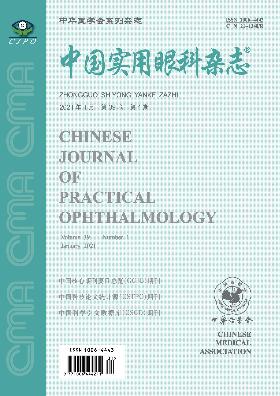Compare the clinical effectiveness of silicone intubation for treating chronic dacryocystitis with different type silicone stents
引用次数: 0
Abstract
Objective To compare the clinic effectiveness of silicone intubation for treating chronic dacryocystitis with different type silicone stents. Methods In a retrospective, nonrandomized comparative case series,from March 2014 to Janurary 2016,696 cases (763 eyes) with chronic dacryocystitis were divided into type A silicone stent group (314 eyes) and type A1 silicone stent group group (449 eyes) depending on the type of silicone stent. And the patients were followed up for 3 months after the removal of tubes.The patency of lacrimal duct, the rate of stent drawn in the correct position for the first time, operation time and incidence of complications were observed. Results After 3 months of postextubation,114 eyes were cured, 74 eyes were improved,126 eyes were failed,the overall successful rate was 59.87% in type A silicone stent group.And 209 eyes were cured, 96 eyes were improved,144 eyes were failed,the overall successful rate was 67.93% in type A1 silicone stent group. The difference between two groups had statistically significance (P =0.022). the stents were drawn in the correct position firstly in 61 eyes in type A silicone stent group, and153 eyes in type A1 silicone stent group. The difference between two groups had statistically significance (P <0.01) .The mean operation time was 13.5min in type A silicone stent group,and 9.7min in type A1 silicone stent group. The difference between two groups were statistically significant (P <0.01). Failure of extubation was observed in 32 eyes in type A silicone stent group and 23 eyes in type A1 silicone stent group. The incidence of extubation failure in type A1 silicone stent group was lower than that in type A silicone stent group with statistically significance (P =0.008). Conclusion Type A1 Silicone stents in the treatment of chronic dacryocystitis were much easier drawn in the correct position firstly than type A silicone stent. They can also shorten operation time, reduce the injury to lacrimal duct mucosa, so that can improve the success rate of surgery. And the incidence of extubation failure was significantly lower than that of type A silicone stent. So that the efficacy of type A1 silicone stent in treatment of chronic dacryocystitis was better than that of type A silicone stent. Key words: chronic dacryocystitis; silicone intubation比较不同类型硅胶支架插管治疗慢性泪囊炎的临床疗效
目的比较不同类型硅胶支架插管治疗慢性泪囊炎的临床疗效。方法回顾性分析2014年3月至2016年1月696例(763只眼)慢性泪囊炎患者,根据硅胶支架类型分为a型硅胶支架组(314只眼)和A1型硅胶支架组(449只眼)。拔管后随访3个月。观察两组泪道通畅程度、支架首次置入正确位置率、手术时间及并发症发生率。结果A型硅胶支架组术后3个月治愈114眼,好转74眼,失败126眼,总成功率为59.87%。A1型硅胶支架组治愈209眼,改善96眼,失败144眼,总成功率67.93%。两组间差异有统计学意义(P =0.022)。A型硅胶支架组61只眼,A1型硅胶支架组153只眼先将支架拉至正确位置。两组间差异有统计学意义(P <0.01)。A型硅胶支架组平均手术时间为13.5min, A1型硅胶支架组平均手术时间为9.7min。两组间差异有统计学意义(P <0.01)。A型硅胶支架组32眼拔管失败,A1型硅胶支架组23眼拔管失败。A1型硅胶支架组拔管失败发生率低于A型硅胶支架组,差异有统计学意义(P =0.008)。结论A1型硅胶支架治疗慢性泪囊炎比A型硅胶支架更容易在正确的位置上先行放置。缩短手术时间,减少对泪管粘膜的损伤,提高手术成功率。拔管失败的发生率明显低于A型硅胶支架。可见,A1型硅胶支架治疗慢性泪囊炎的疗效优于A型硅胶支架。关键词:慢性泪囊炎;硅胶插管
本文章由计算机程序翻译,如有差异,请以英文原文为准。
求助全文
约1分钟内获得全文
求助全文
来源期刊
自引率
0.00%
发文量
9101
期刊介绍:
China Practical Ophthalmology was founded in May 1983. It is supervised by the National Health Commission of the People's Republic of China, sponsored by the Chinese Medical Association and China Medical University, and publicly distributed at home and abroad. It is a national-level excellent core academic journal of comprehensive ophthalmology and a series of journals of the Chinese Medical Association.
China Practical Ophthalmology aims to guide and improve the theoretical level and actual clinical diagnosis and treatment ability of frontline ophthalmologists in my country. It is characterized by close integration with clinical practice, and timely publishes academic articles and scientific research results with high practical value to clinicians, so that readers can understand and use them, improve the theoretical level and diagnosis and treatment ability of ophthalmologists, help and support their innovative development, and is deeply welcomed and loved by ophthalmologists and readers.

 求助内容:
求助内容: 应助结果提醒方式:
应助结果提醒方式:


